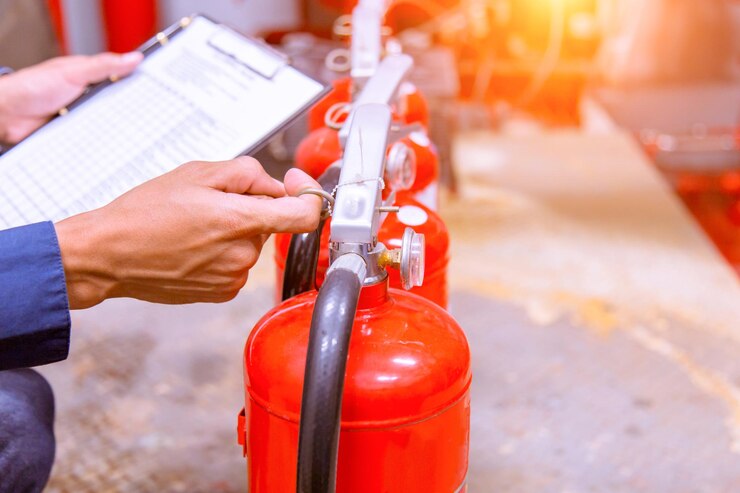Fire safety is a critical aspect of any building’s design, construction, and maintenance. Fire inspections play a vital role in preventing fire hazards, ensuring compliance with local codes, and protecting lives and property. Whether you manage residential properties, commercial facilities, or industrial spaces, understanding fire inspection procedures is essential.
In this complete guide to fire inspection procedures, we’ll cover what fire inspections are, why they matter, the types of inspections, key steps involved, what inspectors look for, and how to prepare effectively.
What Is a Fire Inspection?
A fire inspection is a formal examination of a building or facility by a certified fire inspector to ensure that all fire safety codes, standards, and regulations are being followed. These inspections are typically conducted by local fire departments or third-party agencies and are meant to identify potential fire hazards and ensure fire protection systems are in place and functional.
Why Fire Inspections Are Important
Fire inspections are not just a regulatory requirement—they are a critical safety measure. Here’s why they matter:
-
Life Safety: The main goal is to protect occupants from fire-related injuries or death.
-
Property Protection: Regular inspections help prevent major damage to buildings and contents.
-
Code Compliance: Inspections ensure adherence to fire codes and building regulations.
-
Insurance Requirements: Insurance providers often mandate regular fire inspections to maintain coverage.
-
Legal Liability: Negligence in fire safety can lead to lawsuits or criminal charges.
Types of Fire Inspections
Fire inspections vary depending on the type of building, use, and jurisdiction. Here are the main types:
1. Routine (Annual) Fire Inspections
Most commercial and multi-family residential buildings are subject to annual inspections. Inspectors check for fire code compliance and system functionality.
2. Construction and Renovation Inspections
Before issuing occupancy permits, fire inspectors ensure that fire safety systems in new or renovated buildings meet code requirements.
3. Complaint or Emergency Inspections
These are conducted in response to complaints or incidents involving potential fire hazards or after an actual fire has occurred.
4. Self-Inspections
Some businesses are allowed or required to perform regular self-inspections and submit reports to the local authority.
Fire Inspection Checklist: What Inspectors Look For
Understanding what fire inspectors evaluate helps property owners and managers stay compliant. Here’s a typical fire inspection checklist:
1. Fire Alarms and Smoke Detectors
-
Proper installation of fire alarm systems.
-
Functional smoke detectors in appropriate locations.
-
Systems tested regularly and records maintained.
2. Fire Extinguishers
-
Correct number and type of extinguishers available.
-
Mounted at appropriate heights and locations.
-
Inspection tags updated monthly and annually.
3. Emergency Lighting and Exit Signs
-
Lights and signs are illuminated and functional.
-
Clear visibility of exit routes.
-
Backup power systems tested and working.
4. Fire Sprinkler Systems
-
Sprinklers are unobstructed and in good working order.
-
Maintenance logs up to date.
-
Water pressure and valve functionality tested.
5. Means of Egress
-
Exits are unobstructed and clearly marked.
-
Doors are operational and not locked from the inside.
-
Exit paths are free of hazards and clutter.
6. Electrical Hazards
-
Proper use of extension cords and power strips.
-
Electrical panels accessible and labeled.
-
No exposed wiring or overloaded circuits.
7. Storage and Housekeeping
-
Proper storage of flammable and combustible materials.
-
No storage blocking fire doors, exits, or fire equipment.
-
Waste containers covered and disposed of regularly.
8. Fire Department Access
-
Fire lanes clear and accessible.
-
Knox Box (if applicable) contains current keys.
-
Building address clearly visible from the street.
The Fire Inspection Procedure: Step-by-Step
Here’s what typically happens during a fire inspection:
Step 1: Scheduling and Notification
Most inspections are scheduled in advance. However, unannounced spot checks can occur, especially in response to complaints.
Step 2: Inspector Arrival
The inspector will check in with the property owner, manager, or responsible party. They’ll explain the scope of the inspection and request access to key areas.
Step 3: Walkthrough Inspection
The inspector tours the building, checking safety systems, exits, and hazards. They may take notes, photos, or use a checklist to document findings.
Step 4: Testing Fire Safety Systems
Fire alarms, sprinklers, extinguishers, and emergency lighting may be tested either during the inspection or via verification of recent tests performed by certified professionals.
Step 5: Review of Documentation
Inspectors often review records of:
-
Fire alarm and sprinkler system inspections.
-
Fire extinguisher servicing.
-
Fire drills and training.
-
Electrical inspections and repairs.
Step 6: Exit Interview and Report
Once the inspection is complete, the inspector conducts a final review and discusses any violations found. A formal report is issued with a list of required corrections and deadlines.
Common Fire Code Violations
Understanding the most frequent violations can help you avoid them:
-
Blocked or locked exits.
-
Expired or missing fire extinguishers.
-
Inadequate signage or lighting for exits.
-
Lack of smoke detectors in required areas.
-
Overuse of extension cords or unsafe wiring.
-
Improper storage of flammable materials.
-
Fire doors propped open or damaged.
How to Prepare for a Fire Inspection
Preparation can make the difference between passing or failing an inspection. Follow these steps:
1. Conduct a Self-Inspection
Use a fire safety checklist to identify and correct issues ahead of time.
2. Maintain Proper Records
Keep logs of fire alarm tests, extinguisher servicing, sprinkler maintenance, and fire drills readily available.
3. Train Your Staff
Ensure employees understand emergency procedures and the location of fire safety equipment.
4. Address Past Violations
Review previous inspection reports and ensure all cited issues have been resolved.
5. Work With Professionals
Hire certified fire protection companies to maintain systems and perform routine checks.
Fire Inspection Follow-Up and Corrections
If violations are found during an inspection, a follow-up inspection will likely be scheduled. Here’s how to handle it:
-
Act Quickly: Address violations within the time frame given (often 15–30 days).
-
Document Repairs: Keep receipts, service reports, and photos to show the inspector.
-
Request Extensions If Needed: If a repair takes longer due to parts or scheduling, communicate with the fire inspector promptly.
-
Prepare for Re-inspection: Ensure all corrections are made before the inspector returns.
Fire Safety Best Practices
Beyond just passing inspections, adopting fire safety best practices helps protect your property and its occupants long-term.
-
Install Fire-Rated Doors: They slow the spread of fire and smoke.
-
Conduct Regular Fire Drills: Especially in schools, offices, and large buildings.
-
Label All Hazardous Materials: And store them in approved containers.
-
Create an Emergency Plan: And share it with all occupants or staff.
-
Keep Access Clear: Maintain clear paths to exits and around fire equipment.
Conclusion
Fire inspection are a crucial component of building safety and risk management. They ensure that fire protection systems are functioning, hazards are minimized, and occupants are protected. By understanding the process, common violations, and preparation strategies, property owners and managers can foster a safer environment while staying compliant with local regulations.
Being proactive with fire safety not only improves inspection outcomes but also saves lives and reduces the risk of catastrophic loss. Use this guide as a resource to develop a strong fire safety program and maintain a state of constant readiness.



